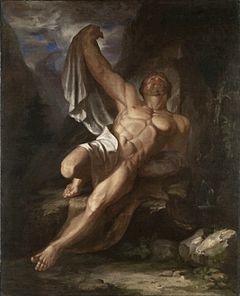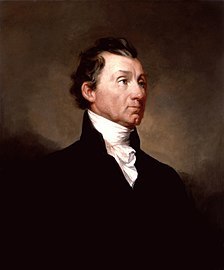Art Lovers discussion
Art and Science
>
Samuel Morse
date newest »
newest »
 newest »
newest »
 History as an artist:
History as an artist:Morse expressed some of his Calvinist beliefs in his painting, Landing of the Pilgrims, through the depiction of simple clothing as well as the people's austere facial features. His image captured the psychology of the Federalists; Calvinists from England brought to North America ideas of religion and government, thus linking the two countries. This work attracted the attention of the notable artist, Washington Allston. Allston wanted Morse to accompany him to England to meet the artist Benjamin West. Allston arranged—with Morse's father—a three-year stay for painting study in England. The two men set sail aboard the Libya on July 15, 1811.
In England, Morse perfected his painting techniques under Allston's watchful eye; by the end of 1811, he gained admittance to the Royal Academy. At the Academy, he was moved by the art of the Renaissance and paid close attention to the works of Michelangelo and Raphael. After observing and practicing life drawing and absorbing its anatomical demands, the young artist produced his masterpiece, the Dying Hercules. (He first made a sculpture as a study for the painting.)
Dying Hercules, Morse's early masterpiece
To some, the Dying Hercules seemed to represent a political statement against the British and also the American Federalists. The muscles symbolized the strength of the young and vibrant United States versus the British and British-American supporters. During Morse's time in Britain, the Americans and British were engaged in the War of 1812. Both societies were conflicted over loyalties. Anti-Federalist Americans aligned themselves with the French, abhorred the British, and believed a strong central government to be inherently dangerous to democracy.

Landing of the Pilgrims

Dying Hurcules
 Critics believe that the elder Morse's Calvinist ideas are integral to Morse's Judgment of Jupiter, another significant work completed in England. Jupiter is shown in a cloud, accompanied by his eagle, with his hand spread above the parties and he is pronouncing judgment. Marpessa, with an expression of compunction and shame, is throwing herself into the arms of her husband. Idas, who tenderly loved Marpessa, is eagerly rushing forward to receive her while Apollo stares with surprise.
Critics believe that the elder Morse's Calvinist ideas are integral to Morse's Judgment of Jupiter, another significant work completed in England. Jupiter is shown in a cloud, accompanied by his eagle, with his hand spread above the parties and he is pronouncing judgment. Marpessa, with an expression of compunction and shame, is throwing herself into the arms of her husband. Idas, who tenderly loved Marpessa, is eagerly rushing forward to receive her while Apollo stares with surprise.
Critics have suggested that Jupiter represents God's omnipotence—watching every move that is made. Some call the portrait a moral teaching by Morse on infidelity. Although Marpessa fell victim, she realized that her eternal salvation was important and desisted from her wicked ways. Apollo shows no remorse for what he did but stands with a puzzled look. Many American paintings throughout the early nineteenth century had religious themes, and Morse was an early exemplar of this. Judgment of Jupiter allowed Morse to express his support of Anti-Federalism while maintaining his strong spiritual convictions. Benjamin West sought to present the Jupiter at another Royal Academy exhibition, but Morse's time had run out. He left England on August 21, 1815, to return to the United States and begin his full-time career as a painter.
The decade 1815–1825 marked significant growth in Morse's work, as he sought to capture the essence of America's culture and life. He painted the Federalist former President John Adams (1816). The Federalists and Anti-Federalists clashed over Dartmouth College. Morse painted portraits of Francis Brown—the college's president—and Judge Woodward (1817), who was involved in bringing the Dartmouth case before the U.S. Supreme Court.
Morse maintained a studio at 94 Tradd St., Charleston, South Carolina, for a short period.
Morse also sought commissions among the elite of Charleston, South Carolina. Morse's 1818 painting of Mrs. Emma Quash symbolized the opulence of Charleston. The young artist was doing well for himself. Between 1819 and 1821, Morse went through great changes in his life, including a decline in commissions due to the Panic of 1819. Unable to stop the rift within Calvinism, his father was forced to resign from his ministerial position, which he had held for three decades. The new branch that formed was the Congregational Unitarians, Morse considered them to be anti-Federalists, as their beliefs were related to religious salvation.
Although Samuel Morse respected his father's religious opinions, he sympathized with the Unitarians. Among the converts to Unitarianism were the prominent Pickerings of Portsmouth, New Hampshire, whom Morse had painted. Some critics thought his sympathies represented his own anti-Federalism. Morse was commissioned to paint President James Monroe in 1820. He embodied Jeffersonian democracy by favoring the common man over the aristocrat.

More...https://en.wikipedia.org/wiki/Samuel_...
To be continued as a scientist...




Read on!